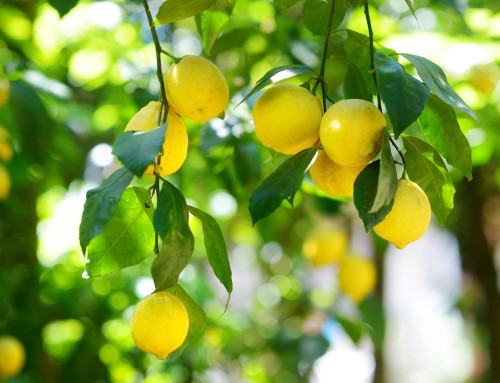
Most of us rejoice when the cold of winter gives way to spring. Yet a large percentage of the population cringe when they see flowers start to bloom, as they know they will soon be experiencing spring allergies.
Surveys show that allergy rates are increasing worldwide and will affect 30-35% of us at some stage of our lives. These increases, which were initially found in Europe and USA, are now being found in all countries undergoing industrial development.
Allergy patterns have changed over time. In previous decades, allergy problems were mostly associated with asthma and hay fever. In more recent years there has been a significant increase in the incidence of food allergies, particularly amongst children. In the UK, up to 50% of children are diagnosed with an allergic condition.
What is an allergy
An allergy is classified as an autoimmune disease. In autoimmune disease our immune system, which protects us from dangers, such as bacteria and viruses, now treats harmless substances, such as food, pollen, or dust mites, as a threat and produces an inappropriate, exaggerated response.
Those researching into the causes of allergies have postulated the following:
- Our gut bacteria (microbiota), which we have inherited over many thousands of years, has a very important role in our immune system. The increased use of antibiotics, at earlier and earlier stages of a child’s life, can cause radical changes in gut bacteria and has been strongly implicated in the unprecedented increase in allergies within children.
- Some scientists have proposed the ‘hygiene hypothesis’ – a child raised in an environment devoid of dirt and germs, and given antibiotics and vaccines that kill beneficial bacteria in their gut, is less able to build up natural resistance to disease. As a result, they become vulnerable to illnesses, such as allergies later in life.
- Poor quality food, especially processed foods and food high in refined carbohydrates, sugar and processed fats, can contribute towards allergies.
- Low vitamin D levels are associated with allergies. Sunshine is the best source vitamin D and children who spend too much time indoors are often lacking in this vitamin.
- Chemicals found in perfumes, cosmetics, paints, carpets and fabrics, car fumes, and industrial pollution can all increase our toxic load and lead to inappropriate immune responses.
Doctors usually ask sufferers to avoid the allergens that cause a reaction. Allergy shots and antihistamines are often prescribed, but both can cause harmful side effects and reactions, which can complicate the situation.
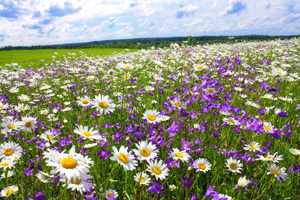 Maharishi AyurVeda’s take on springtime allergies
Maharishi AyurVeda’s take on springtime allergies
It is traditionally during spring that allergies proliferate and Ayurveda give a good reason why this is the case.
According to Ayurveda, as the temperature rises during springtime, Ama (digestive impurities) that has built up inside our body during the cold weather, starts to liquefy. The liquefaction process gives our cells and tissues the chance to push out any unwanted material. This toxic Ama flows into, and gradually clogs up, our body-channels (Shrotas). When our Shrotas are blocked, they are hampered in their ability to either delivered nutrient to our cells or remove waste material. The result is that our body’s immune systems become overwhelmed.
And it just so happens that during springtime flowers burst into bloom and fill the air with pollen. So, at the same time that our body’s defences are being challenged, potential allergens in the environment are increasing. The result is an increased incidence of allergies during spring.
In respiratory allergies, a sub-dosha of Kapha (our body’s structuring element), called Shleshaka Kapha, is involved. Shleshaka Kapha is responsible for maintaining moisture in the upper respiratory tract.
As Ama in the body starts melting, it combines with Shleshaka Kapha. This forms a thick, sticky form of Ama called Shleshma, which gradually fills the sinus cavities and the respiratory tract. As a result our respiratory system can becomes a fertile ground for breeding bacteria and viruses. This is why many allergies can go on to create secondary sinus and respiratory problems.
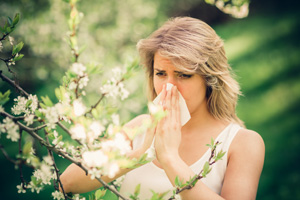 How do you improve your body resistant to allergens?
How do you improve your body resistant to allergens?
Maharishi AyurVeda’s solution is to deal with the underlying causes of allergies and to help your immune system effectively withstand them. This can only happen when you enliven your body’s natural resistance.
Ayurveda see allergens, such as plants, pollen, chemicals or food, as only indirect implicated. The real cause occurs when digestive impurities, called Ama, accumulate in your body and interfere with its defences.
For example, when Ama builds up in the skin, exposure to otherwise harmless substances, such as sesame oil, can cause rashes or irritation. When an allergen is breathed in Ama, accumulated in the lungs, can react with it and cause breathing problems.
Ama interferes with the proper function of our cells and with our defence system. The solution is to maintain your body’s purification system, so that it is more effective at eliminating toxins.
Recommendations from Maharishi AyurVeda
Spices
Research has found that spices can help maintain resistance to plant-induced allergies.
- Turmeric contains , which acts as a decongestant. It also has anti-inflammatory, analgesic and anti-bacterial properties.
- Cumin, coriander, red pepper and sage are known to maintain resistance to allergies.
- A tasty way of incorporating some of these valuable spices into your diet is by sautéing ground turmeric, cumin and coriander in ghee, until their flavours are released. Add seasonal vegetables to this mix and cover and cook with a little water and salt.
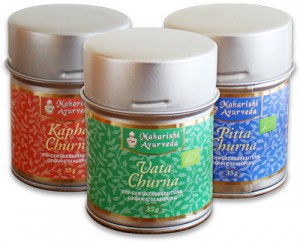 Kapha-Pitta pacifying diet
Kapha-Pitta pacifying diet
Disturbances in both the Kapha (structuring) and the Pitta (transforming) Doshas are involved in allergies, especially during spring. Both a Kapha and a Pitta pacifying diet will help maintain balance at this time of year.
Sprinkling Pitta Churna spice blend on your lunch, and drinking Pitta Tea, helps keep Pitta Dosha in balance at mid-day, when Pitta is at its highest level. To counteract sluggish digestion and congestion Kapha Churna and Kapha Tea are useful in the morning and evening when Kapha is highest. It is also especially important to pacify Kapha during the Kapha season (spring).
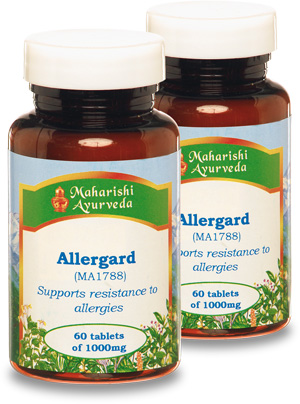 Allergard (MA1788)
Allergard (MA1788)
Allergard (MA1788) supports your body’s natural resistance to allergens. It helps your body avoid toxic reactions, it reduces the toxic Ama that lead to reactions with allergens, it supports digestion, it helps decrease sensitivity and it help nourish liver functioning.
Amrit Kalash MA4 and MA5
The Amrit Nectar and Amrit Ambrosia herbal supplements support the total health of your body and improved its resistance. Scientific studies have shown that Amrit supports the function of the immune system, the detoxification system and the nervous system.
General Dietary Recommendations
- Avoid eating leftovers and pre-cooked meals as they are a rich source of toxic Ama.
- Avoid carbonated drinks as they are high in refined sugar and fructose, both of which disrupt your gut bacteria and your hormonal system.
- Avoid iced drinks as they slow digestion, which can result in accumulated Ama.
- For balanced nutrition, include all six tastes in your meals – sweet, sour, salty, pungent, bitter and astringent. Our spice blends offer an easy way to include all six tastes at each meal.
- Drink plenty of warm or hot water as this help clear impurities from your Shrotas (body channels).
Lifestyle Recommendations
- Take good care of your body and avoid known allergens.
- To allow your body to better absorb vital nutrients, it is best to avoid watch TV or reading while eating. Focus on enjoying and savouring your meal.
- Nature has designed the time between 10pm and 2am to be your body’s natural purification period. So the best to get to bed is 10pm.



